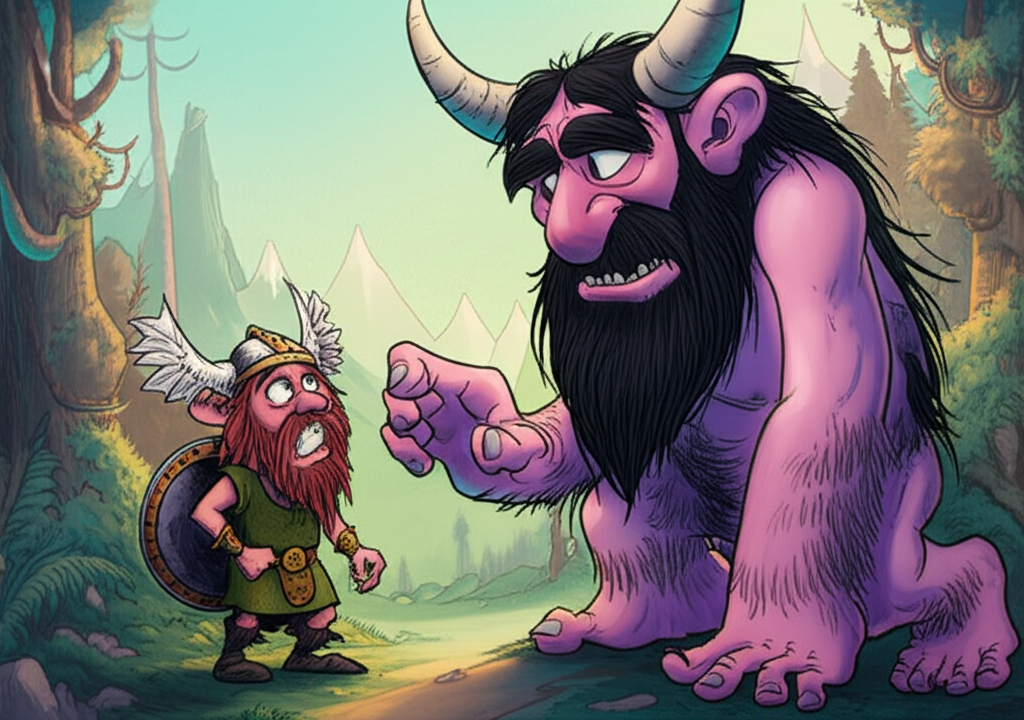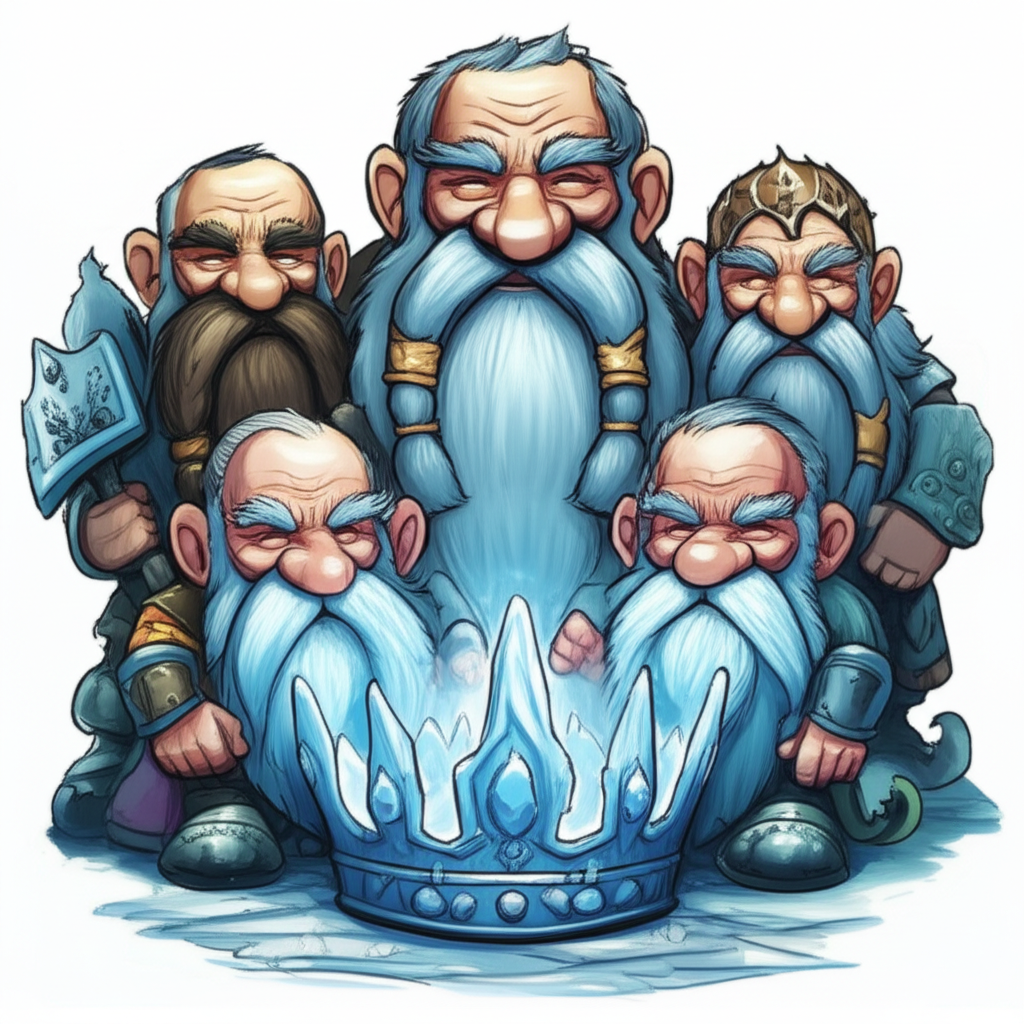
The Forging of Gods: Echoes of the Aesir-Vanir War in the Aftermath of Muspelheim
An Important Note: The following article explores a story from Norse mythology, a collection of traditional beliefs and legends from the Scandinavian people of the Viking Age. These tales are presented for cultural, historical, and educational understanding. They are part of humanity’s rich folkloric heritage and are not intended to be regarded as factual or as a subject of worship.
Introduction
From the windswept fjords and dense, misty forests of ancient Scandinavia comes a rich tapestry of myths that sought to explain the world’s chaos and wonders. These stories, passed down through generations of skalds (poet-singers) and eventually recorded in texts like the Poetic Edda and Prose Edda, tell of gods, giants, and the cyclical nature of creation and destruction. One of the foundational conflicts in this mythology is the Aesir-Vanir War, a primordial clash between two distinct tribes of deities. This article will explore that ancient conflict through a narrative lens, imagining its legacy in the quiet, desolate aftermath of Ragnarok—the prophesied end of the world brought about by the fires of Muspelheim.
Origins and Cultural Background
These myths flourished during the Viking Age (roughly 8th to 11th centuries CE), a period defined by exploration, trade, and raiding. The people of this era lived in a harsh, often unforgiving environment, where the turning of the seasons, the fury of the sea, and the ever-present threat of winter were dominant forces. Their worldview was shaped by this reality. They envisioned a cosmos of Nine Realms, all connected by the great world tree, Yggdrasil. Time was not linear but cyclical, and even the gods were subject to a powerful force known as Wyrd, or fate. Their stories are not of infallible, perfect beings, but of flawed, powerful figures who struggled with honor, betrayal, wisdom, and their own mortality. This cultural context of struggle and resilience is key to understanding the meaning behind their myths.
The Figures of the Conflict
To understand the war, one must first understand the combatants. They were not simply good versus evil, but two different expressions of divine power.
-
The Aesir: Residing in the celestial fortress of Asgard, the Aesir were deities primarily associated with order, power, warfare, and leadership. Figures like Odin, the All-Father, embodied the pursuit of wisdom through sacrifice and cunning. Thor, his son, represented raw strength and the protection of the cosmic order. The Aesir were, symbolically, the embodiment of the structured, warrior-led society. They valued honor, oaths, and strength in battle.
-
The Vanir: Hailing from the fertile realm of Vanaheim, the Vanir were gods of nature, prosperity, wisdom, and a potent form of magic known as seiðr. Freyja and her twin brother Freyr were among their most prominent figures, symbolizing love, fertility, bountiful harvests, and peace. The Vanir represented the untamed, cyclical forces of the natural world and the esoteric knowledge connected to it.
-
Surtr and Muspelheim: A figure outside this conflict, yet central to its ultimate conclusion, is Surtr. He is a primordial being, a fire giant from Muspelheim, the realm of eternal fire. He wields a flaming sword that is said to be brighter than the sun. Symbolically, Surtr is not an evil entity in a moral sense, but rather a force of pure, inevitable destruction—the chaotic fire that purges the old world to make way for the new.
Main Story: The Ashes of Asgard and the Memory of a War
The world was quiet now. The roar of Surtr’s all-consuming flame had faded, leaving behind a sky of soft grey and a land washed clean, green with new life. On the plain of Idavoll, where the golden halls of Asgard once stood, only scorched foundations and twisted metal remained. The great fire of Muspelheim had fulfilled its fated purpose, reducing the Nine Realms to ash and memory.
But not all was lost. From the shadows of the old world, a few survivors emerged. Baldr the Beautiful and his blind brother Hodr, returned from the land of the dead, walked together in the silence. Thor’s sons, Magni and Modi, clutched their father’s mighty hammer, Mjolnir, its weight a heavy reminder of a world that was no more. Vidar and Vali, sons of Odin, stood gazing at the horizon, their hearts filled with a sorrow too deep for words.
They were the children of the Aesir, the inheritors of a broken legacy. As they gathered amidst the ruins, a cool breeze whispered through the new grass, carrying with it the scent of damp earth and the echoes of a distant past.
It was Baldr, his face serene despite the desolation, who spoke first. "We remember the end," he said, his voice soft but clear. "The Fenris Wolf unchained, the World Serpent’s venom, the fire of Surtr. But do we remember the beginning? The first war that shaped us?"
A stillness fell over the small group. They all knew the story. Long before the giants threatened their existence, the gods had warred amongst themselves. The Aesir, with their pride and martial prowess, had looked upon the Vanir’s powerful magic with suspicion and greed. They had insulted and attacked Gullveig, a Vanir sorceress, sparking a conflict that shook the foundations of the cosmos.
The Aesir-Vanir War had been a bitter stalemate. Odin’s spear could not overcome the Vanir’s deep magic, and the formidable walls of Asgard could not be breached by the Vanir’s forces. The Aesir brought order and strategy; the Vanir brought the raw, unpredictable power of nature and life itself. The war raged until both sides, exhausted and weary, realized that neither could achieve victory.
To forge a peace, they exchanged hostages. The Vanir sent their finest: Njord, the god of the sea, and his children, Freyr and Freyja. In return, the Aesir sent the wise but unassuming Hoenir and Mimir, the keeper of immense knowledge. This exchange was more than a truce; it was a merging. Freyja taught the Aesir the secrets of seiðr, while Odin shared with her the runes. The wisdom of the Vanir—of harvest, prosperity, and the cycles of nature—was woven into the warrior culture of the Aesir. They became one pantheon, stronger and more complete than before.
"That first war taught us a lesson we almost forgot," Modi, son of Thor, murmured, his grip tightening on Mjolnir. "We thought ourselves different. Aesir and Vanir. War and peace. Order and nature. We built our halls and drew lines between our realms."
"And then Muspelheim came," Vidar added, his voice a low rumble. "Surtr’s fire did not distinguish between an Aesir warrior and a Vanir sorcerer. It burned the halls of Odin and the fields of Freyr with equal fury. In the face of true oblivion, our old titles meant nothing."
They looked at each other, a new understanding dawning in their eyes. They were not just the sons of Aesir gods. They were the inheritors of a unified legacy, a culture forged in that first, internal war. The resilience needed to survive Ragnarok was not born on the final battlefield, but in the peace treaty that had united two warring tribes ages ago. The wisdom of Mimir, the prosperity of Freyr, the magic of Freyja, the strength of Thor, the sacrifice of Odin—all of it had been necessary. Their union had allowed a remnant to endure, a seed from which a new world could grow.
Standing on the ashes of the old, they were no longer just Aesir. They were simply the gods, guardians of a new beginning, carrying the lessons of two wars: one that taught them how to live with each other, and one that taught them the price of failure.
Symbolism and Meaning
For the ancient Norse people, this grand narrative likely held profound symbolic weight. The Aesir-Vanir War is often interpreted by scholars as a mythological representation of the integration of different cultures or social classes. It may reflect a historical conflict between a warlike, sky-oriented cult (the Aesir) and a more earth-based, fertility-focused people (the Vanir), with their eventual unification creating a more balanced society. The story emphasizes that a culture needs both order and structure (Aesir) as well as prosperity and harmony with nature (Vanir) to thrive.
The Aftermath of Muspelheim (Ragnarok) represents the core Norse belief in a cyclical universe. Unlike linear end-of-the-world scenarios, Ragnarok is not just an ending but a violent rebirth. The destruction wrought by Surtr is a cleansing fire, purging a world grown old and corrupt. The survival of a new generation of gods symbolizes hope, renewal, and the idea that even after the most devastating catastrophe, life finds a way to begin again, carrying the wisdom of the past into the future.
Modern Perspective
Norse mythology has seen a remarkable resurgence in modern popular culture. Its themes of heroism, fate, and cosmic struggle continue to resonate with contemporary audiences.
- In Literature and Film: Marvel Comics and the subsequent Marvel Cinematic Universe have transformed Thor, Odin, and Loki into global icons, albeit with significant creative liberties. Authors like Neil Gaiman, in his book Norse Mythology, have retold these ancient stories for a new generation, preserving their original spirit while making them accessible.
- In Video Games: The mythology provides a rich wellspring for interactive storytelling. Games like God of War (2018) and its sequel offer a mature, character-driven reinterpretation of the gods, exploring themes of fatherhood and breaking cycles of violence. The world of Assassin’s Creed Valhalla allows players to immerse themselves in a recreation of the Viking Age, where these myths are an integral part of the culture and worldview.
In these modern forms, the Aesir, Vanir, and the epic tales of their lives and deaths serve as powerful archetypes, inspiring stories about power, family, destiny, and the eternal struggle between order and chaos.
Conclusion
The story of the Aesir-Vanir War and its imagined legacy after Ragnarok is a testament to the sophisticated worldview of the ancient Norse people. It is a cultural artifact, a way for a past society to explore complex ideas about conflict, unity, and renewal. These myths are not presented as literal truth but as powerful expressions of the human imagination, grappling with the great questions of existence.
As Muslims, we recognize that only Allah is the true Creator and Sustainer of the universe, the sole source of all power and wisdom. Studying these myths allows us to appreciate the diversity of human culture and the timeless tradition of storytelling, through which people throughout history have sought to find meaning in the world around them. They remain a vital part of our shared global heritage, reminding us of the enduring power of myth to capture the hopes, fears, and wisdom of a people.





